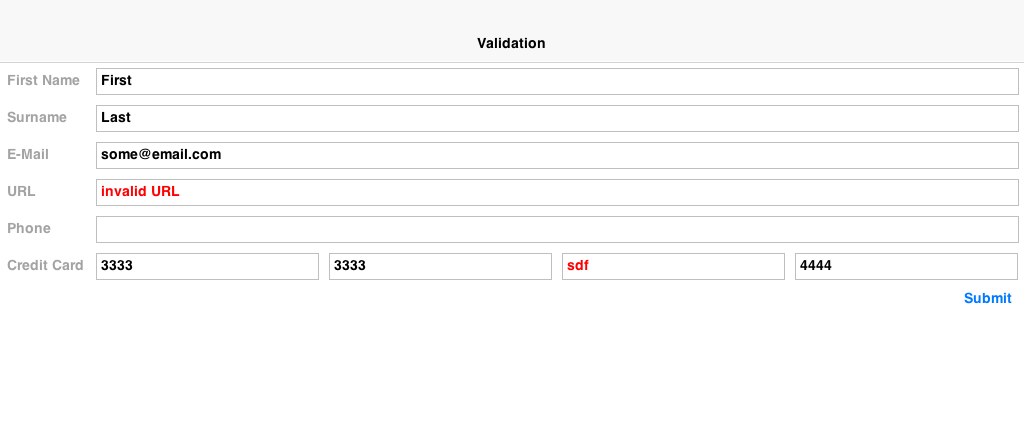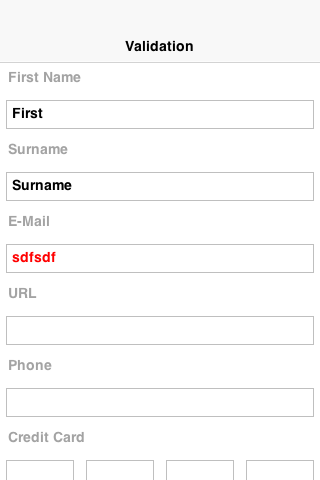

Up until recently we had to handcode validation logic into every form, this becomes tedious as we work
thru larger applications. Some developers built their own generic logic, which leads to obvious duplication
of effort. In the interest of keeping everything together we decided to release a standardized validation
framework that allows us to define constraints on a set of components, mark invalid entries and disable
submission buttons.
Since we wanted regular expressions as a feature in the validation framework we incorporated an old regular
expression cn1lib that Steve ported into the API as well. This allows us to write regex in Codename One although
we didn’t integrate it as deeply as it is in JavaSE to avoid some of the overhead and potential incompatibilities.
You can see the RegEx package
description for further details.
Using validation is pretty trivial, we use the Validator class to add constraints which define
the validation constraints for a specific component. We can also define the components to disable/enable
based on validation state and the way in which validation errors are rendered (change the components UIID,
paint an emblem on top etc.). A Constraint is an interface that represents validation requirements.
You can define a constraint in Java or use some of the builtin constraints such as LengthConstraint,
RegexConstraint etc.
Masking isn’t a part of validation per se but it is such a common concept that I feel its use is warranted in this
short tutorial. Masking allows us to define input with a given structure e.g. credit card comprising of 16 digits
split into groups of 4. This is common for date entry and many other types of input, we’d love to offer a more
powerful masked input API in the future but for now you can implement a poor mans solution by using a
DataChangedListener and stopping the current editing/moving to the next field based on
constraints. We implemented such masking as a sample in the code below together with a rather complete
validation sample.
This sample below has a couple of neat tricks, the UI changes between tablet and phone form factor. It demonstrates
masking and various types of validation. It also demonstrates disabling the submit button to show that validation
failed and prevent the user from proceeding.
public void start() {
if(current != null){
current.show();
return;
}
Form val = new Form("Validation");
TableLayout tl;
int spanButton = 2;
if(Display.getInstance().isTablet()) {
tl = new TableLayout(7, 2);
} else {
tl = new TableLayout(14, 1);
spanButton = 1;
}
tl.setGrowHorizontally(true);
val.setLayout(tl);
val.addComponent(new Label("First Name"));
TextField firstName = new TextField();
val.addComponent(firstName);
val.addComponent(new Label("Surname"));
TextField surname = new TextField();
val.addComponent(surname);
val.addComponent(new Label("E-Mail"));
TextField email = new TextField();
email.setConstraint(TextArea.EMAILADDR);
val.addComponent(email);
val.addComponent(new Label("URL"));
TextField url = new TextField();
url.setConstraint(TextArea.URL);
val.addComponent(url);
val.addComponent(new Label("Phone"));
TextField phone = new TextField();
phone.setConstraint(TextArea.PHONENUMBER);
val.addComponent(phone);
val.addComponent(new Label("Credit Card"));
Container creditCardContainer = new Container(new GridLayout(1, 4));
final TextField num1 = new TextField(4);
final TextField num2 = new TextField(4);
final TextField num3 = new TextField(4);
final TextField num4 = new TextField(4);
num1.setConstraint(TextArea.NUMERIC);
num2.setConstraint(TextArea.NUMERIC);
num3.setConstraint(TextArea.NUMERIC);
num4.setConstraint(TextArea.NUMERIC);
creditCardContainer.addComponent(num1);
creditCardContainer.addComponent(num2);
creditCardContainer.addComponent(num3);
creditCardContainer.addComponent(num4);
val.addComponent(creditCardContainer);
Button submit = new Button("Submit");
TableLayout.Constraint cn = tl.createConstraint();
cn.setHorizontalSpan(spanButton);
cn.setHorizontalAlign(Component.RIGHT);
val.addComponent(cn, submit);
Validator v = new Validator();
v.addConstraint(firstName, new LengthConstraint(2)).
addConstraint(surname, new LengthConstraint(2)).
addConstraint(url, RegexConstraint.validURL()).
addConstraint(email, RegexConstraint.validEmail()).
addConstraint(phone, new RegexConstraint(phoneRegex, "Must be valid phone number")).
addConstraint(num1, new LengthConstraint(4)).
addConstraint(num2, new LengthConstraint(4)).
addConstraint(num3, new LengthConstraint(4)).
addConstraint(num4, new LengthConstraint(4));
automoveToNext(num1, num2);
automoveToNext(num2, num3);
automoveToNext(num3, num4);
v.addSubmitButtons(submit);
val.show();
}
private void automoveToNext(final TextField current, final TextField next) {
current.addDataChangeListener(new DataChangedListener() {
public void dataChanged(int type, int index) {
if(current.getText().length() == 5) {
Display.getInstance().stopEditing(current);
String val = current.getText();
current.setText(val.substring(0, 4));
next.setText(val.substring(4));
Display.getInstance().editString(next, 5, current.getConstraint(), next.getText());
}
}
});
}




12 Comments
Hi Shai,
Is the Validator and RegexConstraint present in the current plugin or will come with the next update?
Phone number validation, will it work against 07123456789 or +97123456789 or both?
My suggestion on autoMoveToNext…Instead of checking the input on 5th letter why not 4 and just move the cursor to the next field for entry.
Lastly, will the keyboard close and re-open when stopEditing() and editString() are called? Or make the keyboard flashes?
Hi,
it made it into the current plugin and should be there already.
Notice I just used the RegexConstraint for a phone, you can define any regex you want. We hardcoded email/URL since those are common and slightly more standardized.
Auto move might be an interesting approach to masking, this is one of those things we need to think about.
Yes, the keyboard does flash. On my iphone this felt acceptable.
A regex containing (?= does not seem to work yet. Example, a password that should contain at least one lowercase character:
“^(?=.*[a-z]).{8,24}$”
I don’t think lookarounds are supported. The Javadocs don’t mention them, and the code doesn’t look like it accommodates them:
[http://www.codenameone.com/…](http://www.codenameone.com/javadoc/com/codename1/util/regex/RE.html)
If I were you I would just break this up into two constraints. E.g. The regex “[a-z]” will be sufficient to make sure it contains at least one lowercase character, and you can do the length constraint separately.
Hi, thank you for an excellent work, and having used the Validator, I ran into the following issues:
1. when I use the Validtor.setShowErrorMessageForFocusedComponent(true), the popup error message does not close as expected after correcting the invalid email/text or losing the focus on the TextField, and the only way to get ride of it, is to lose and gain the focus again on the TextField!.
2. No internationalisation support for the error message and inline with the Label component. for example, you cannot use the RegexConstraint.validEmail(“[invalid.email](http://invalid.email)”) to retrive the localized message from the resource file.
3. As the time of writing this!!, I have no idea on how to style the popup error component via CSS lib!!
PLease advice if this is something was overlooked from my end?? and many thanks in advnce.
1. Was this on a device?
2. If you installed the bundle correctly you should see it localized.
3. See setErrorMessageUIID(). It uses the PopupDialog UIID for the content itself.
1. on the simulator,
On the device text entry behaves quite differently.
Shai, keyboard will not close after automovenext(). This will lead to an issue when the device is rotated. Text in the field will display in the wrong location and misaligned as well.
Is the parent container scrollable on the Y axis?
Android resizes the screen on edit so you need to leave enough room for the text field in such cases.
Yes scrollable on Y-Axis. But this is happening other way around when the tablet flipped form portrait mode to landscape.
Can you post a screenshot? What do you mean by “other way around”?